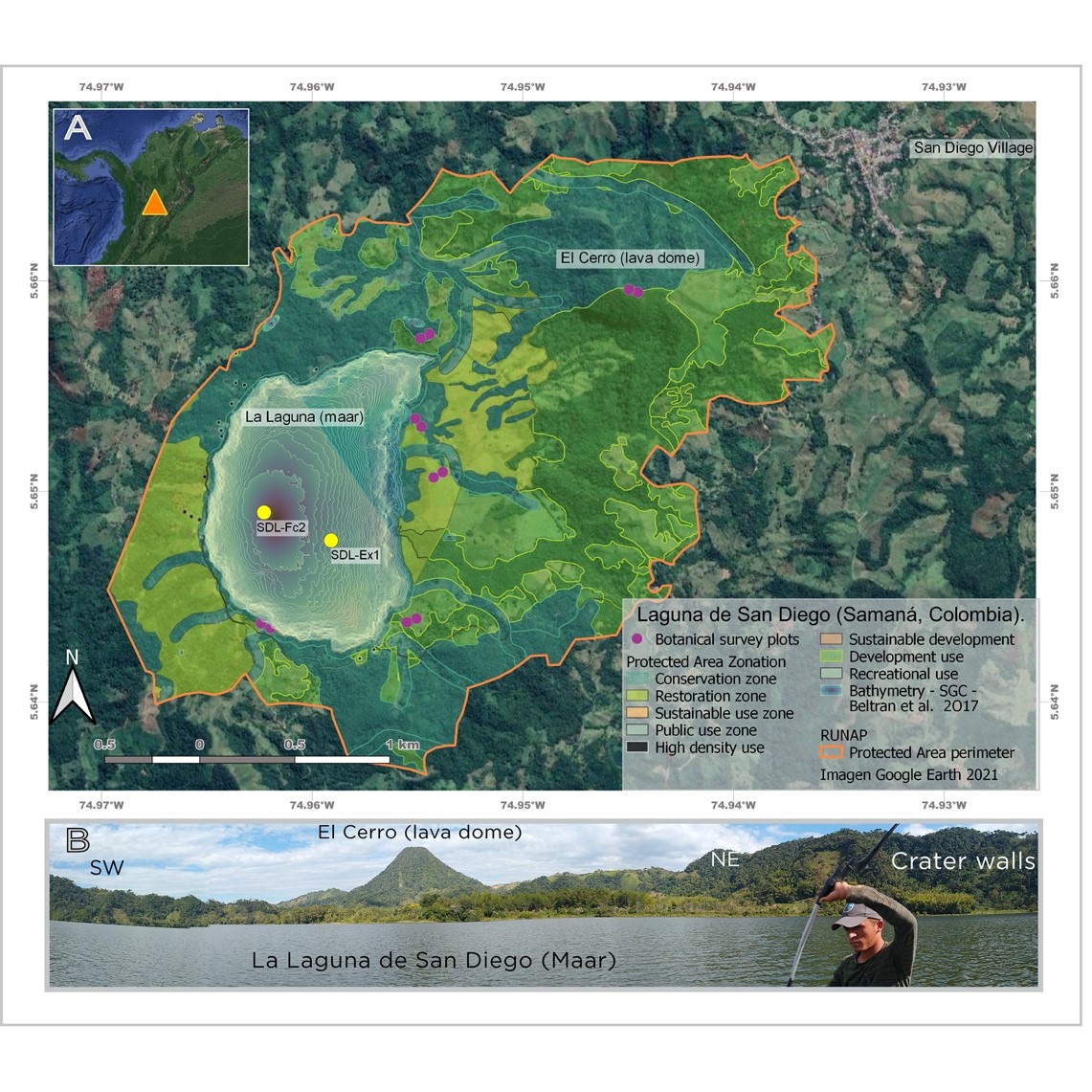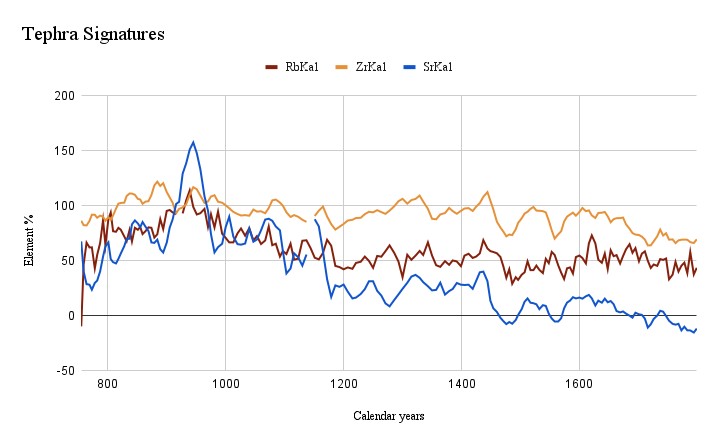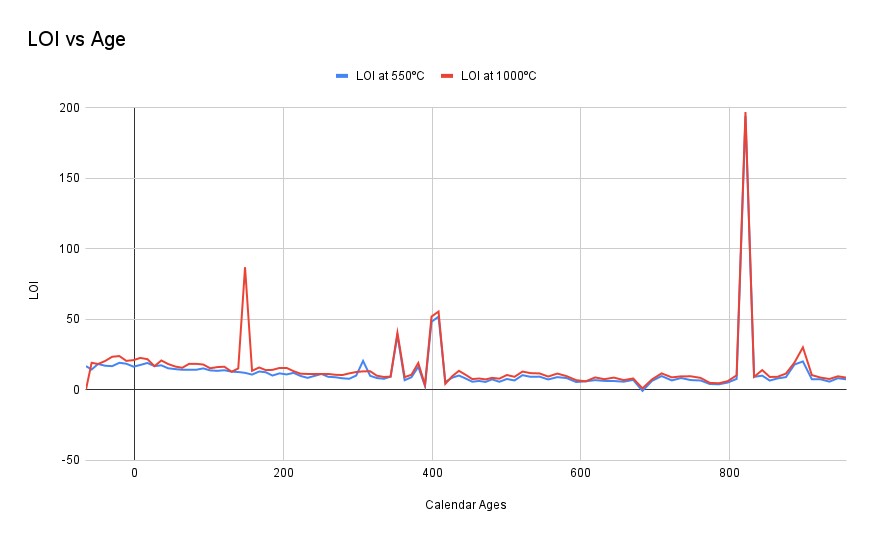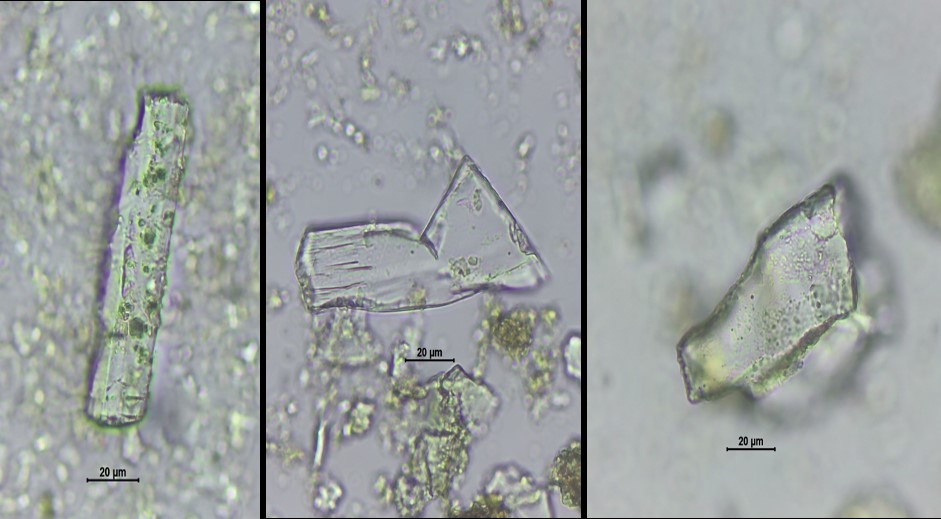Social and Behavioral Science
136 Developing a Protocol for Detecting Volcanism through Andean Lake Sedimentary Records
Lauren Page; Mitchell Power (Geography); and Susana Velásquez-Franco (Geography)
Faculty Mentor: Mitchell Power (Geography, University of Utah)
Abstract
Volcanism is likely the main contributor to disturbances made on the surrounding ecosystems in the Andes. Volcanism can be a powerful disturbance agent, creating a range of changes from blasting impacts, to ash fallout and nutrient enrichment, to high species mortality in ecosystems. In the Colombian Andes volcanism has evolved over the past 5 million years with San Diego Cerro Machin Volcanic Tectonic Providence (SCVPT) as the most active volcanic region, and a large contributor to natural disturbances in northern South America. This research seeks to explore and refine laboratory protocols of detecting volcanism through the analysis of lake sedimentary records using a combination of methods. We carry out elementary analysis via Micro XRF data and smear slide analysis, and Loss Of Ignition (LOI) procedures in SDLEx1 52 cm long record that spans the last 1200 years. Our preliminary analysis shows that Rb, Si, Zr, & K, which are related to volcanic activity of Cerro Bravo and Ruiz volcanoes, spikes around 100 years ago. In smear slide analysis, tephra shards were found throughout several samples, with validation of tephra located in the same core sections analyzed with XRF. Lastly, LOI showed that minerals and organics in the area are strongly correlated and both spike at approximately 0 800 years ago. Combining findings with previous studies can give further analysis of disturbances in Andean lake watersheds. This in turn, can give knowledge on the past frequency and impact of volcanic eruptions to the people living in these watersheds, as we learn more about the ecosystem’s responses both locally and regionally.
INTRODUCTION
Volcanism can be a powerful disturbance agent, creating a range of changes from blasting impacts, to ash fallout and nutrient enrichment, to high species mortality in ecosystems. In the Colombian Andes volcanism has evolved over the past 5 million years with San Diego Cerro Machin Volcanic Tectonic Providence (SCVPT) as the most active volcanic region, and a large contributor to natural disturbances. White and Picket (1985) define a disturbance as, “any relatively discrete event that disrupts the structure of an ecosystem, community, or population, and changes resource availability or the physical environment.” As Turner (2010) describes in her publication titled; “Disturbance and landscape dynamics in a changing world,” disturbances are a natural, important part of ecological processes that can leave lasting impacts on an ecosystem. Scientific studies on natural disturbance regimes are critically needed as humans continue to alter the planet, and these findings should be included in policies for risk management and assessment. Understanding how various disturbances drive ecosystem change will allow a better understanding of critical processes, and how specific ecosystems, like the Andean forests, might respond to disturbances now and in the future.
Laguna De San Diego is part of the San Diego volcano; It is made up of a maar and a lava dome, both apart of the Samaná Monogenetic Volcanic Field (SMVF) (Figure 1. A.). These geologic features (the maar and dome) are located on the eastern slope of the Central Cordillera in the Andean Northern Volcanic Zone (ANVZ). The maar is the result of a phreatomagmatic eruptive phase that started approximately 20,000 yrs. ago, ending as a lava effusive phase around 18,000 yrs ago, resulting in the lava dome. The basement rocks below the maar are comprised of Triassic age metamorphic rock. A Maar is a wide, low volcanic crater, produced by a phreatic-magmatic eruption – an explosion caused by groundwater coming into contact with lava or magma. The maar is 2.1 x 1.5 km in size at an altitude of about 1000 m. The lagoon itself sits 250 m below the rim of the crater at an altitude of 770 m and the depth of the lagoon is about 53m (Figure 1.B.). The San Diego dome is 450 m above the lagoon to the North and is 240 m tall (Borrero et al. 2016). Tephra deposits found in the lake would likely be sourced from volcanoes Cerro Bravo (Lescinsky, 1990) and El Ruiz (Ceballos et al. 2020), located SW from Laguna De San Diego.
Crisafulli and Dale (2018) use the example of the explosion of Mount St. Helens to document ecosystem responses to such types of disturbance. The specific mechanisms of a volcanic-driven disturbance (heat, force of impact, abrasion, burial, chemical toxicity, etc.) can vary in both intensity and type, creating a range of impacts to species and landscapes. Across multiple studies, ecological responses varied spatially and temporally, with biotic, abiotic, and human factors all influencing the response. While some plants are adapted for survival by having tall leaves extending above tephra deposits, other species form mutualistic relationships with fungi and bacteria (e.g. Gunnera sp.) for succession and growth. Secondary physical disturbances such as landslides, erosion, and management practices (road clearing, logging) following an eruption all continued to shape and create ecosystem change for years after the event. Surrounding watersheds and river channels are typically impacted by heavy increase in sediment load that continued long after the initial explosion (Crisafulli & Dale, 2018). These and other studies provide some ideas on the potential response of tropical ecosystems to volcanism, and this research focuses on the Andean lake sediment record from Laguna de San Diego (SDL) located in the Colombian Andes. This research is aimed at providing new insights on how tropical ecosystems respond to large-scale natural disturbances.
Figure 1. Study site. A. Andean Northern Volcanic Zone (ANVZ), SDL protected area perimeter, and maar bathymetry with yellow dots on coring sites. B. SDL maar and lave dome.

METHODS
In the Field
Lake sediment cores – Excalibur and frozen cores were taken in January 2020 by Dr. Mitchell Power and Susana Velasquez-Franco. Excalibur core (SDL-Ex1) was retrieved from 30 m depth. This is the primary core used in analysis. In February 2023, I was able to join Dr. Mitchell Power and Susana Velasquez-Franco in collecting two additional freeze cores from SDL (SDL-FC3 & SDL-FC4) at depths of 50 m.
In the lab
For the XRF analysis, using the SDL-EX1 core, we ran sub-samples of 2 mm for elemental signatures. After that we filtered the data for elements Rb, Zr, and Sr as signatures for tephra based on previous tephra studies conducted by McClean et al. 2022 and Peti et al. 2019. We graphed these elements against their calendar years. For age control, we ran an age-depth model using Bacon R package based on three C14 dates – 400, 460, and 1070.
For the Loss on Ignition (LOI) analysis we put 1cm2 of samples from SDL-EX1 core into ceramic bowls. The samples were put into the kiln 3 separate times, firing them at temperatures of 100ºC, 550ºC, and 900ºC. Between each firing the samples were weighed.
For tephra analysis we created smear slides, following R Rothwell’s (1989) method – which involves taking a pin drop size sample, some distilled water, and mixing them together on a microscope slide. We then used a hot plate to evaporate the water and mounted the sample with Silicon oil and a cover slide. Samples taken were from depths of 11cm, 15cm, and 33cm of the core. Samples were looked at through an optical microscope and tephra Identification was done using the University of Minnesota Tool for Microscopic Identification (TMI) database. They define tephra as “. . . a mixture of volcanic glass and crystalline grains derived from the same volcanic source. A tephra unit in a core may be predominantly crystalline and coarse-grained at the base, grading upwards to finer, more glassy grains,” and volcanic glass as, “Transparent colorless to pale gray, green, or brown. Nonpleochroic. Isotropy is a diagnostic feature, although devitrification may cause low-order birefringence at edges of grains. Moderate relief. May have bubble or pipe vesicles, stretching textures, cuspate to lunate bubble wall shards with sharp edges. May be disseminated throughout other sediment or occur in pure layers. Tephra may also contain crystalline grains from the same eruption or reworked material.”
RESULTS
While each individual signature has different peaks throughout the 1200-year time span, Rb, Zr, and Sr all have correspondingly large peaks at approximately 900 years ago (Fig.2).
In terms of the LOI analysis, the samples yielded high mineral and organic compositions around 800 years ago (Fig. 3). Lastly the smear slides all contained tephra shards (fig. 4). Each of these analyses individually and together indicate volcanic activity. Based on a study by Ceballos et al. 2020 the Nevado El Ruiz (NVR) volcano had phreatomagmatic eruptions at this time (≈900 yrs ago). Additionally, a study by Lescinky et al. 1990 indicates that Cerro Bravo (CB) had pumice flows also at this time (≈800 yrs ago).
Figure 2. Elementary analysis via XRF.

Figure 3. Loss of Ignition (LOI).

Figure 4. Tephra Shards. From left to right – depths of 11cm, 15cm, 33cm.

CONCLUSION & FUTURE WORK
Volcanism is one of many disturbances in the Tropical Andean Ecosystem, but it is a prominent one, and can cause huge impacts due to being such a powerful disturbing agent. Through my induvial research, using techniques of XRF, LOI, and Smear Slides, I was able to find confirming evidence of volcanic activity in the SDL region during the last 1200 years, namely around 900 years ago. While we cannot say what specific volcano is linked to these peaks, other studies have shown that both NVR and CB were undergoing volcanic activity during this time. Since the smear slides that were created were at no specific age, going forward continued smear slide analysis would need to take samples at depths that correspond with XRF signaling to see if there is an increase in tephra shards. Further, use of a petrographic microscope with smear slides would be helpful in identification of tephra shards. Lastly, pollen analysis would be helpful to test the impact of eruptions on vegetation composition.
For the research community, this project validates sedimentary analysis to confirm the presence of tephra deposits in Andean lake records. For environmentalists and ecologists it helps in learning how volcanism affects ecological communities over time on the study area. Combining findings with previous studies can give further analysis of disturbances in Andean lake watersheds. This in turn, can give knowledge on the past frequency and impact of volcanic eruptions to the people living in these watersheds, as they can learn more about their region and the ecosystem they reside in.
ACKNOWLEGEMENTS
Overall, my research here is part of a much larger PhD project conducted by Susana Velasquez-Franco who is studying a range of disturbances and impacts at SDL and other volcanic Andean sites. Her research questions focus on how what we learn about the environment can influence stakeholder decision making. By understanding the past climate and conditions of the tropical rainforests of Colombia, better management practices can be made going forward. I am beyond thankful for her guidance in this research, the opportunities she has provided me, the push to get out of my comfort zone and travel to Colombia to conduct field work, and for being an inspiring woman in STEM.
I would also like to thank Dr. Mitchell Power who has been a great mentor both in the lab and in the field. I am grateful for his dedication to his students, his work, and to discovery. His passion for research and constantly discovering new things rubs off on everyone and makes even the most taxing jobs exciting, as you know you are in pursuit of unearthing old secrets about a place.
Lastly, I would like to thank the Office of Undergraduate Research for giving me this opportunity. Through them I was awarded a travel grant that helped me go to Colombia to do field research and see the site I was doing lab work on for an entire year prior. My undergraduate research journey has been all together challenging, and so entirely rewarding.
REFERENCES
Borrero, C., Murcia, H., Agustín-Flores, J., Arboleda, M. T., & Giraldo, A. M. (2017). Pyroclastic deposits of San Diego maar, central Colombia: an example of a silicic magma-related monogenetic eruption in a hard substrate. Geological Society, London, Special Publications, 446(1), 361-374.
Ceballos-Hernández, J. A., Martínez-Tabares, L. M., Valencia-Ramírez, L. G., Pulgarín-Alzate, B. A., Correa–Tamayo, A. M., & Narváez-Marulanda, B. L. (2020). Geological evolution of the Nevado del Ruiz Volcanic Complex. The Geology of Colombia, 4, 267-296.
Crisafulli, C. M., & Dale, V. H. (Eds.). (2018). Ecological responses at Mount St. Helens: Revisited 35 years after the 1980 eruption (pp. 47-111). New York, NY: Springer.
Lescinsky, D. T. (1990). Geology, Volcanology, and Petrology of Cerro Bravo, a Young, Dactic, Stratovolcano in West-Central Colombia. Louisiana State University and Agricultural & Mechanical College.
Rothwell, R.G. (1989). The Smear Slide Method. In: Minerals and Mineraloids in Marine Sediments. Springer, Dordrecht. https://doi.org/10.1007/978-94-009-1133-8_2
Turner, M. G. (2010). Disturbance and landscape dynamics in a changing world. Ecology, 91(10), 2833-2849.
White, P. S., and S. T. A. Pickett. 1985. Natural disturbance and patch dynamics: an introduction. Pages 3-13 in S. T. A. Pickett and P. S. White, editors. The ecology of natural disturbance and patch dynamics. Academic Press, New York, New York, USA

